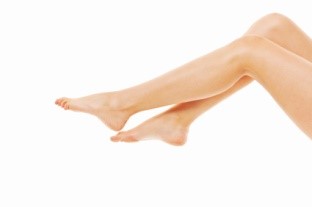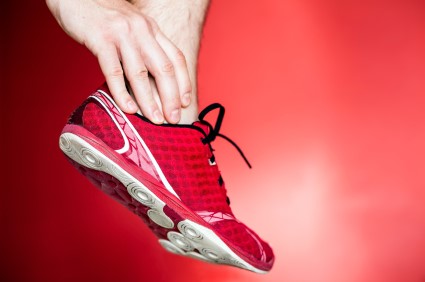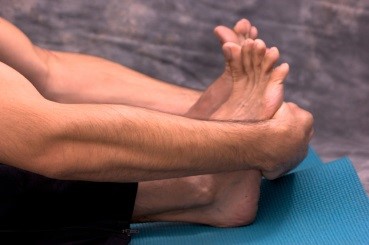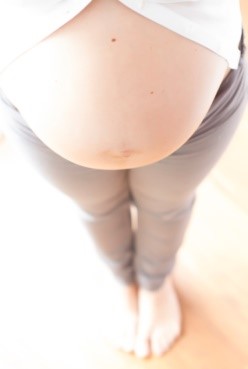April 2015
Hammertoe
Hammertoe can also be caused by complications from rheumatoid arthritis, osteoarthritis, trauma to the foot, heredity, or a cerebral vascular accident. Pain and difficult mobility of the toes, deformities, calluses, and corns are all symptoms of a hammertoe.
Someone who suspects they have the symptoms of a hammertoe should consult with a physician—particularly a podiatrist. Podiatrists diagnose and treat complications of the foot and ankle. If the podiatrist discovers that the affected toes are still flexible, treatment for the hammertoe may simply involve exercise, physical therapy, and better-fitting shoes. Treatment for hammertoes typically involves controlling foot mechanics, such as walking, through the use of customized orthotics.
For more serious cases in which the toes have become inflexible and rigid, surgery may be suggested. During the operation, the toe would receive an incision to relieve pressure on the tendons. A re-alignment of the tendons may then be performed by removing small pieces of bone to straighten the toe. In some cases, the insertion of pins is needed to keep the bones in the proper position as the toe heals. The patient is usually allowed to return home on the same day as the surgery.
If surgery is performed to repair a hammertoe, following the postoperative directions of your doctor is pertinent. Directions may include several stretches, picking up marbles with your toes, or attempting to crumple a towel placed flat against your feet. Wear shoes that have low heels and a wide amount of toe space to maintain comfort. Closed shoes and high heels should be avoided. Shoes with laces allow the wearer to adjust how fitted her or she may want the shoes to be and also allow for greater comfort
. To provide adequate space for your toes, select shoes that have a minimum of one-half-inch of space between the tip of your longest toe and the inside of the shoe. This will also relieve pressure on your toes and prevent future hammertoes from forming.
Other preventative measures that can be taken include going shopping for new shoes in the middle of the day.
Your feet are its smallest in the morning and swell as the day progresses; trying on and purchasing new shoes midday will give you the most reliable size. Be sure to check that the shoes you purchase are both the same size. If possible, ask the store to stretch out the shoes at its painful points to allow for optimum comfort.
New Hammertoe Procedure Can Correct Pain and Aesthetic of the Condition
 Having shoes that correspond with today’s fashion is almost a necessary part of life today; unfortunately when people suffer from hammertoes it feels as though any shoe is too painful to wear.
Having shoes that correspond with today’s fashion is almost a necessary part of life today; unfortunately when people suffer from hammertoes it feels as though any shoe is too painful to wear.
Recently, a new procedure has been set in place where implants would be used to permanently straighten the joints in the foot. The implant, called TENFUSE, is said to be made out of cortical bone and will not have to be removed since the implant will eventually become a part of the bone. If the implant works as well as expected, this could be great news for the 10 to 20% of Americans suffering from the condition.
Hammertoes can be a painful condition to live with. If you are suffering from hammertoes, contact Dr. Stephen Schwartz DPM of Pennsylvania. Our doctor will treat your foot and ankle needs.
Hammertoe
Hammertoe is a foot deformity that affects the joints of the second, third, fourth, or fifth toes of your feet. It is a painful foot condition in which these toes curl and arch up, which can often lead to pain when wearing footwear.
Symptoms
- Pain in the affected toes
- Development of corns or calluses due to friction
- Inflammation
- Redness
- Contracture of the toes
Causes
- Genetics – people who are genetically predisposed to hammertoe are often more susceptible
- Arthritis – because arthritis affects the joints in your toes, further deformities stemming from arthritis can occur
- Trauma – direct trauma to the toes could potentially lead to hammertoe
- Ill-fitting shoes – undue pressure on the front of the toes from ill-fitting shoes can potentially lead to the development of hammertoe
Treatment
- Orthotics – custom made inserts can be used to help relieve pressure placed on the toes and therefore relieve some of the pain associated with it
- Medications – oral medications such as anti-inflammatories or NSAIDs could be used to treat the pain and inflammation hammertoes causes. Injections of corticosteroids are also sometimes used
- Surgery – in more severe cases where the hammertoes have become more rigid, foot surgery is a potential option
If you have any questions please contact our offices located in Chambersburg and Mcconnellsburg, PA. We offer the newest diagnostic and treatment technologies for all your foot and ankle needs.
Read More about Hammertoes
What to Know About a Broken Toe
Trauma to the foot, especially the toes, can occur in many ways. Banging them, stubbing them, or dropping something on them are a few different ways this trauma can occur. Given the fact that toes are positioned in front of the feet, they typically sustain the brunt of such trauma. When trauma occurs to a toe, the result can be a painful break or fracture. Another type of trauma that can break a toe is repeated activity that places stress on the toe for prolonged periods of time.
Broken toes can be categorized as either minor or severe fractures. Symptoms of minor toe fractures include throbbing pain, swelling, bruising on the skin and toenail, and the inability to move the toe with ease. Severe toe fractures require medical attention and are indicated when the broken toe appears crooked or disfigured, when there is tingling or numbness in the toe, or when there is an open, bleeding wound present on the toe.
Generally, a minor toe break will heal without long-term complications, but it is important to discontinue activities that put pressure on the toe. It is best to stay off of the injured toe and immediately get a splint or cast to prevent any additional movement of the toe bones. You can also immobilize your toe by placing a small cotton ball between the injured toe and the toe beside it, then taping the two toes together with medical tape. Swelling can be alleviated by placing an ice pack on the broken toe directly as well as elevating your feet above your head.
Severe toe fractures may be treated with a splint, cast, and in some cases, minor surgery; especially when the big toe has been broken. Due to its position and the pressure it endures with daily activity, future complications can occur if the big toe is not properly treated. Pain associated with minor toe fractures can be managed with over-the-counter pain medications, and prescription pain killers may be necessary for severe toe fractures.
The healing time for a broken toe is approximately four to six weeks. In severe cases where the toe becomes infected or requires surgery, healing time can take up to eight weeks or more. While complications associated with a broken toe are immediately apparent, it is important to note that there are rare cases when additional complications, such as osteoarthritis, can develop over time. You should immediately speak with your podiatrist if you think you have broken your toe due to trauma, as they will be able to diagnose the injury and recommend the appropriate treatment options.
Real Madrid Star Ends Season Early With Broken Toe
 Gareth Bale of Real Madrid could have an early end to his season due to a broken toe. The winger injured the toe during training had to miss the team’s game against Rayo Vallecano. Coach Carlo Ancellotti does not want to put Bale at risk for it may hurt him in the long run. Experts believe that his toe may be fracture which will take considerably longer to heal. Bale’s club mate James Rodriguez faced a similar problem earlier in the season and was out for two months.
Gareth Bale of Real Madrid could have an early end to his season due to a broken toe. The winger injured the toe during training had to miss the team’s game against Rayo Vallecano. Coach Carlo Ancellotti does not want to put Bale at risk for it may hurt him in the long run. Experts believe that his toe may be fracture which will take considerably longer to heal. Bale’s club mate James Rodriguez faced a similar problem earlier in the season and was out for two months.
A broken toe is extremely painful and needs immediate attention. If you have any concerns about your feet contact podiatrist Dr. Steven Schwartz of Pennsylvania. Our doctor will treat your foot and ankle needs.
What to Know About a Broken Toe
Although most people try to avoid foot trauma such as banging, stubbing, or dropping heavy objects on their feet, the unfortunate fact is that it is a common occurrence. Given the fact that toes are positioned in front of the feet, they typically sustain the brunt of such trauma. When trauma occurs to a toe, the result can be a painful break (fracture).
Symptoms of a Broken Toe
- throbbing pain
- swelling
- bruising on the skin and toenail
- the inability to move the toe
- toe appears crooked or disfigured
- tingling or numbness in the toe
Generally, it is best to stay off of the injured toe with the affected foot elevated.
Severe toe fractures may be treated with a splint, cast, and in some cases, minor surgery. Due to its position and the pressure it endures with daily activity, future complications can occur if the big toe is not properly treated.
If you have any questions please feel free to contact our offices located in Chambersburg and Mcconnellsburg, PA. We offer the newest diagnostic tools and technologies to treat your foot and ankle needs.
Exercising the Feet is a Great Way to Prevent Future Injury
 According to Dr. Howard Osterman, AMPA spokesperson, feet are the most neglected part of the body and many foot injuries occur because of overuse without the proper support. With the right amount of exercise of the feet, strength can be built and injury and be reduced. Osterman recommends trying to pick up a towel or marbles with the toes and standing on one foot for ten seconds to build arch strength. “Every exerciser is worried about the position of their ankles, knees, and hips, but so much of that stability starts at the foot,” Osterman advises.
According to Dr. Howard Osterman, AMPA spokesperson, feet are the most neglected part of the body and many foot injuries occur because of overuse without the proper support. With the right amount of exercise of the feet, strength can be built and injury and be reduced. Osterman recommends trying to pick up a towel or marbles with the toes and standing on one foot for ten seconds to build arch strength. “Every exerciser is worried about the position of their ankles, knees, and hips, but so much of that stability starts at the foot,” Osterman advises.
Exercising your feet regularly is a great way to prevent injuries. If you have any concerns about your feet contact Dr. Steven Schwartz of Pennsylvania. Our doctor will treat your foot and ankle needs.
Exercise for Your Feet
Exercise for your feet can help you to gain strength, mobility and flexibility in your feet. They say that strengthening your feet can be just as rewarding as strengthening another part of the body.
Your feet are very important and often we forget about them in our daily tasks. But it is because of our feet that are we able to get going and do what we need to. For those of us fortunate not to have any foot problems, it is an important gesture to take care of them to ensure its good health in the long run.
Some foot health exercises can include ankle pumps, tip-toeing, toe rise, lifting off the floor doing reps and sets, also flexing the toes and involving the shins may help too. It is best to speak with your doctor regarding how to do these fitness steps and how often is right for you. Everyone’s needs and bodies are different and it varies from individual to individual to determine what should be done for you to maintain strength in your feet.
Once you get into a routine of doing regular exercise, you may notice a difference in your feet and how strong they may become.
If you have any questions, please feel free to contact our offices located in Chambersburg and Mcconnellsburg, PA. We offer the newest diagnostic tools and technologies to treat your foot and ankle needs.
Read more about exercising your feet.
Study Finds Pregnancy can Permanently Alter Women’s Feet
 According to a study conducted by the University of Iowa, pregnancy can permanently change the size and shape of women’s feet. Typically pregnant women experience a range of different foot problems: flattened arches, swollen feet, and because of the weight gain, these changes can become long term effects.
According to a study conducted by the University of Iowa, pregnancy can permanently change the size and shape of women’s feet. Typically pregnant women experience a range of different foot problems: flattened arches, swollen feet, and because of the weight gain, these changes can become long term effects.
The study included 49 pregnant women that had their arches measured during their first trimester of pregnancy and five months after birth. Nearly 60 – 70% of women showed signs of longer and wider feet. Women who were experiencing their first pregnancy also showed the greatest amount of foot change.
“It is possible that these foot changes that occur during pregnancy may help explain why, in comparison with men, women are at higher risk for pain or arthritis in their feet,” stated Neil Segal, researcher of the University of Iowa.
Pregnancy can put a significant strain on women’s feet. If you have any concerns on pregnancy and the feet contact Dr. Steven Schwartz of Pennsylvania. Our doctor will treat your foot and ankle needs.
What foot problems can arise during pregnancy?
One problem that can occur is over-pronation, which occurs when the arch of the foot flattens and tends to roll inward. This can cause pain and discomfort in your heels while you’re walking or even just standing up, trying to support your baby.
Another problem is edema, or swelling in the extremities. This often affects the feet during pregnancy, but tends to occur in the later stages.
How can I keep my feet healthy during pregnancy?
- Wearing orthotics can provide extra support for the feet and help distribute weight evenly
- Minimize the amount of time spent walking barefoot
- Wear shoes with good arch support
- Wear shoes that allow for good circulation to the feet
- Elevate feet if you experience swelling
- Massage your feet
- Get regular, light exercise, such as walking, to promote blood circulation to the feet
If you have any questions feel free to contact our offices located in Chambersburg and Mcconnellsburg, PA. We offer the newest diagnostic and treatment technologies for all your foot and ankle needs.
Read more about pregnancy and the feet.
Study Finds Pregnancy can Permanently Alter Women’s Feet
 According to a study conducted by the University of Iowa, pregnancy can permanently change the size and shape of women’s feet. Typically pregnant women experience a range of different foot problems: flattened arches, swollen feet, and because of the weight gain, these changes can become long term effects.
According to a study conducted by the University of Iowa, pregnancy can permanently change the size and shape of women’s feet. Typically pregnant women experience a range of different foot problems: flattened arches, swollen feet, and because of the weight gain, these changes can become long term effects.
The study included 49 pregnant women that had their arches measured during their first trimester of pregnancy and five months after birth. Nearly 60 – 70% of women showed signs of longer and wider feet. Women who were experiencing their first pregnancy also showed the greatest amount of foot change. “
It is possible that these foot changes that occur during pregnancy may help explain why, in comparison with men, women are at higher risk for pain or arthritis in their feet,” stated Neil Segal, researcher of the University of Iowa.
Pregnancy can put a significant strain on women’s feet. If you have any concerns on pregnancy and the feet contact Dr. Steven Schwartz of Pennsylvania. Our doctor will treat your foot and ankle needs.
What foot problems can arise during pregnancy?
One problem that can occur is over-pronation, which occurs when the arch of the foot flattens and tends to roll inward. This can cause pain and discomfort in your heels while you’re walking or even just standing up, trying to support your baby.
Another problem is edema, or swelling in the extremities. This often affects the feet during pregnancy, but tends to occur in the later stages.
How can I keep my feet healthy during pregnancy?
- Wearing orthotics can provide extra support for the feet and help distribute weight evenly
- Minimize the amount of time spent walking barefoot
- Wear shoes with good arch support
- Wear shoes that allow for good circulation to the feet
- Elevate feet if you experience swelling
- Massage your feet
- Get regular, light exercise, such as walking, to promote blood circulation to the feet
If you have any questions feel free to contact our offices located in Chambersburg and Mcconnellsburg, PA. We offer the newest diagnostic and treatment technologies for all your foot and ankle needs.
Read more about pregnancy and the feet.

